The Noosphere Is Here
The great Jesuit anthropologist, Pierre Teilhard de Chardin, has long fascinated us with his vision that the world would evolve into a “noosphere,” [1] a great web of consciousness enveloping the Earth. It seemed a lovely but distant ideal, yet the Digital Revolution has now made that dream a reality. The noosphere is here today, and it promises to transform our lives, our work, social institutions, the global order, and our very minds and souls.
Not too long ago, we relied on telephones and newspapers to communicate. We now use two billion personal computers, 14 billion cell phones and laptops, and two billion TVs. The information flows through 30 million Internet servers, 3,500 space satellites and almost one million miles of undersea cables. This planetary layer of digital connection knits eight billion people into a living overlay of thought – the noosphere.
Although the world has an abundance of communication, it is not a very happy place. Just as the Gutenberg printing press unleashed a flood of information that led to wars and the Protestant Reformation, today’s deluge of knowledge has not stemmed a “post-factual” wave of nonsense, government gridlock, raging pandemics, the climate crisis and other global threats. I suggest that a “global consciousness” able to handle such threats is likely to emerge soon. But, in the meantime, the noosphere has highlighted the limits of knowledge.
Beyond Knowledge
You would think we should have been enlightened by the past two decades of the Knowledge Age, so why do people seem badly misinformed, emotional and unreasonable? Despite the great evidence readily available, many do not believe in evolution, climate change, vaccination and other established science.
It does not help that large parts of the public embrace this confusion. TV and the Internet have produced what has been called “the dumbest generation” with a disregard for general reading in favor of news sources echoing their beliefs. [3] Here are some choice bits of willful ignorance:
- The US ranks near the bottom of nations whose citizens believe in evolution, with less than 40 percent saying they accept the science. [4]
- Two-thirds cannot name the three branches of government. [5]
- As of early 2021, more than 70 percent of Republicans still believe the presidential election was stolen, after this was discredited by the courts and Republican officials themselves.
Norman Lear, the famous American TV producer, said: “We just may be the most-informed, yet least self-aware people in history.” [9]
This dilemma poses one of the great ironies of our time. The Digital Revolution has created a wealth of knowledge that is almost infinite. The smartphone alone has made the world’s store of information available at the touch of a finger. There is no shortage of knowledge, but the power of facts is badly limited. Knowledge cannot tell us what is worth doing, or what is right morally and what is wrong. Rational logic does not explain why people are altruistic or selfish, kind or cruel, enlightened or ignorant. Knowledge can never replace love, wisdom or a guiding vision.
The rule of unreason pervades life, and it is rampant in politics. The US government, for instance, has been locked in stalemate for decades, though Congress has more knowledge than it can handle. Emotional issues like abortion, gun control and immigration supported by strong majorities have been studied to death. Still, gridlock persists because of conflicting values, reluctance to compromise, and hunger for power. Senator Ben Sasse worried, “We are living in an America of perpetual adolescence.” [10]
This political stalemate is largely responsible for the poor US response to the coronavirus pandemic. China, Singapore, South Korea and other Asian nations weathered the storm reasonably well. But the US mismanaged it so badly that Americans fear structural weaknesses in government could inflict more damage from other crises. The pandemic brought these systemic flaws on vivid display for all to see. People are frightened and searching for solutions.
What is going on here? Why is the US, the most prosperous nation in the world, so inept? How can great knowledge produce such misguided behavior?
These problems can be best understood as the passing of the Knowledge Age and the opening of a new frontier – consciousness itself. A “beyond knowledge test” helps clarify the role of consciousness. If some problem remains unresolved due to values, beliefs, self-interest or other subjective issues – climate, abortion, gun control, for example – the solution lies beyond knowledge. This simple test highlights how the disorders that plague our time are not rational problems to solve by reason. They involve all the messy mental baggage of normal people, so they must be addressed by altering consciousness. That is where the problems lie, and it is also where the solutions are to be found.
This is a bold claim, but that is roughly how the shift to a world of knowledge looked when the Information Revolution began a few decades ago. Back when computers filled rooms, I recall telling people that we were entering a world of personal computers, and the typical response was, “Why would anyone want a personal computer?” Yet in 2000, PCs were everywhere, books on knowledge became rife and the majority of jobs involved managing knowledge. I am equally confident that an Age of Consciousness is opening up today, and we simply do not yet understand this intriguing new frontier.
Beneath this tectonic shift in consciousness is the driving force of artificial intelligence, the most powerful agent of change today. Sundar Pichai, CEO of Google, said “AI is probably the most important thing humanity has ever worked on … more profound than fire or electricity.” [12] The advance of AI is automating knowledge work, threatening to eliminate roughly half of all jobs and posing one of the most perplexing questions of our time: What lies beyond knowledge?
I have struggled with this problem for years, and the result is Figure 1 showing the “Life Cycle of Evolution (LCE).” Similar graphs have been sketched in general terms, [13] but this is the first to plot the long-term evolutionary trend using real scales and real data. The logarithmic time scale is needed to encompass the billions of years at the start of life, as well as just decades today. Without a log scale, the shape of the LCE would not be recognizable; the trendline would run flat and make a sharp 90 degree turn straight up.
Figure 1
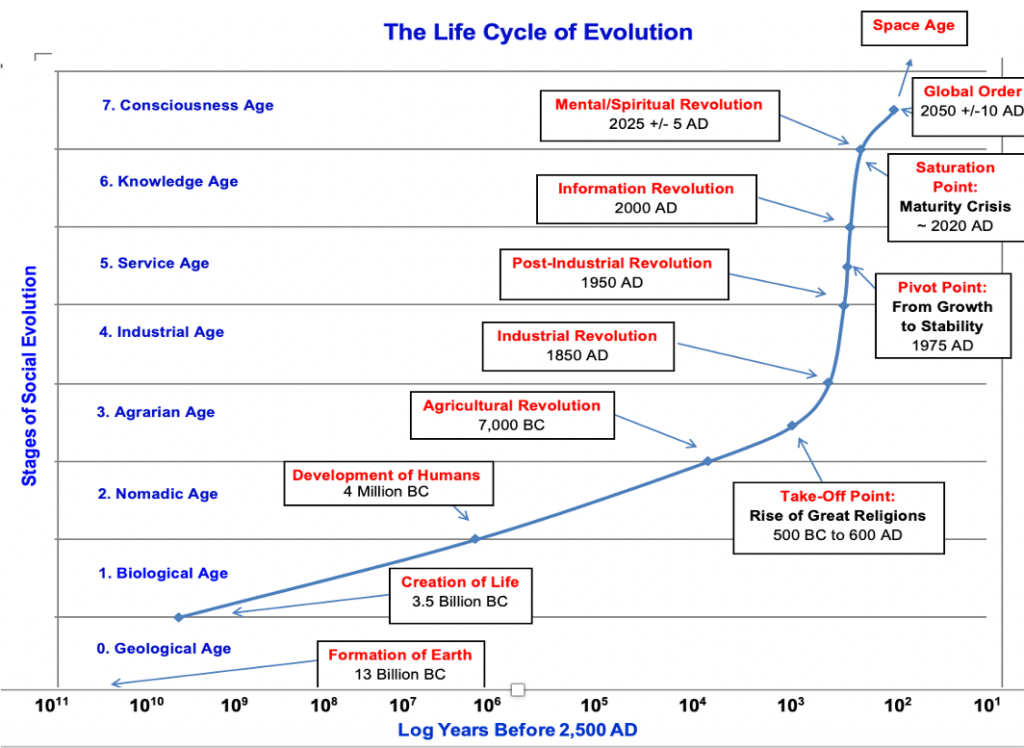
Above the fray, there is a direction to this accelerating evolutionary process, and the logical next step is consciousness. Roughly four million years were needed to found Agrarian Civilizations. Nine thousand years to invent Industrial Society. One hundred years for the Post-Industrial Era. Five decades to a Knowledge Age. And the past 20 years to an Age of Consciousness.
Today, the world is poised at the cusp of transformation from a society based on knowledge to one guided by consciousness. This extraordinary acceleration through previous stages reveals how the planet suddenly came alive in a flash of awareness. The entire rise of civilization occurred in an extremely tiny fraction of one percent in the LCE. Historian Arnold Toynbee foresaw it as the “etherealization of life.” [14] Teilhard de Chardin envisioned planetary consciousness to be the natural apex of evolution – the Omega Point. [15]
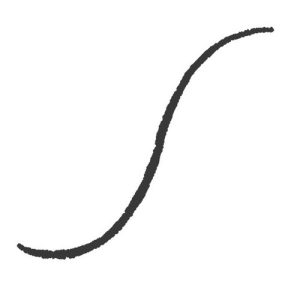 The great S-curve formed by these eras is the universal symbol of the lifecycle. All living systems pass through this same process of birth (start of the S-curve), growth (upward phase), and maturity (leveling off) – a culture of bacteria, a growing child or the life of a planet. From this systems view, the Global MegaCrisis is an infinitely larger version of the same crisis of maturity that transforms teenagers into adults. Anyone who has raised children knows that teens may be fully grown physically and “know everything.” But the typical teenager has not learned to control their impulses, struggles with inner doubts and can’t cope with a confusing world.
The great S-curve formed by these eras is the universal symbol of the lifecycle. All living systems pass through this same process of birth (start of the S-curve), growth (upward phase), and maturity (leveling off) – a culture of bacteria, a growing child or the life of a planet. From this systems view, the Global MegaCrisis is an infinitely larger version of the same crisis of maturity that transforms teenagers into adults. Anyone who has raised children knows that teens may be fully grown physically and “know everything.” But the typical teenager has not learned to control their impulses, struggles with inner doubts and can’t cope with a confusing world.
At some point, the stress becomes so severe that most teens eventually find the courage to grow up and become responsible adults. In a roughly similar way, the MegaCrisis is humanity’s challenge to become a mature civilization. The world is being forced to grow up and to develop a sustainable global order – or perish. This passage to maturity is more than a historic challenge; it is also a historic opportunity. Like adolescence, surmounting this painful process can lead to a better future. How could we let this singular moment pass?
Triumph of Human Spirit
Shifts in public consciousness are transforming the major organs of society – government, business, universities, religions and other institutions. In each case, a small avant-garde is quietly bringing a mature awareness to these varied facets of public life.
Many doubt dramatic change is possible. However, in 2020, the Black Lives Matter movement began shifting attitudes around the world, illustrating that consciousness is ever-changing. This push for racial justice is led by young people across the political and racial spectra, the cohort that favors global consciousness. It is reminiscent of the Me Too movement that outed sexual predators, and the passing of gay marriage laws a few years ago. Big change arrives when the time has come.
The power of global consciousness provides the key to resolving the multiple crises of today. Each stage in social evolution has been propelled by revolutions – the Agrarian Revolution, the Industrial Revolution, Post-Industrial Revolution and, most recently, the Information Revolution. As my graph of the LCE lays out visually, we are now in the beginning throes of a “Mental/Spiritual Revolution” to kick-start the Age of Consciousness. In short, it appears the world is heading toward some type of historic shift in consciousness, a collective epiphany, a new mindset, code of global ethics or a spiritual revolution.
Civilization survived the fall of Rome, the Dark Ages, World Wars I and II, and a cold war bristling with nuclear weapons, and it seems likely to survive the Global MegaCrisis.
Such heroic change may appear daunting, especially at a time when hostilities seem endless and environmental disaster looms. That is often the case before upheavals. Nobody thought the Soviet Union would collapse until it actually did.
The reason this claim seems optimistic, perhaps even foolhardy, is that we have no experience in global consciousness. Huddled in our small section of the universe, humans have little conception of planetary evolution, much less the transition to a unified world. Our understanding is roughly similar to that of a naïve person who first witnesses the agony of a human birth or a teen struggling to adulthood. Without previous experience, these painful transitions would seem awful, too hard to bear. Yet they are entirely normal and usually successful.
So too could our passage to global maturity develop into a fairly normal transition in a few years. The LCE graph shows that a Mental/Spiritual Revolution is poised to arrive about 2025 or so. This historic shift to an unknown era requires a new conceptual framework to map the terrain, a vision to provide inspiration and principles that work.
A mature global order will still bear the normal human failings, but it will make our current strife look as primitive as the brutal reign of kings in the feudal ages. This may sound too good to be true, yet these trends suggest we will see the beginnings of a unified planet over the next decade or so, and the triumph of human spirit, once again.


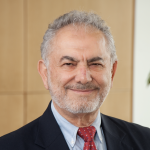
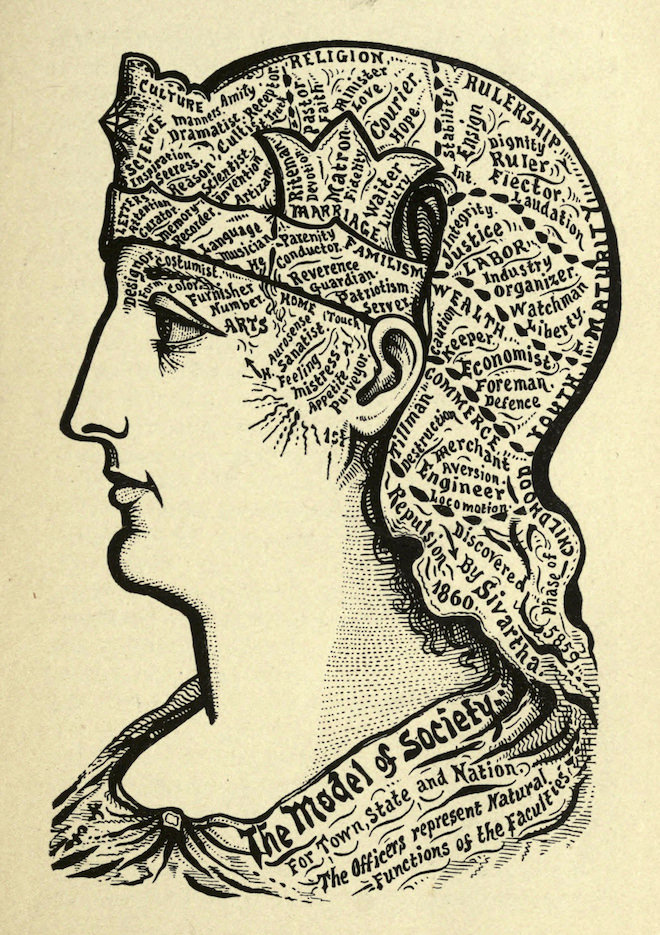
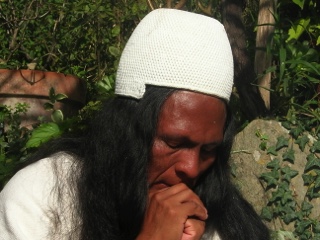

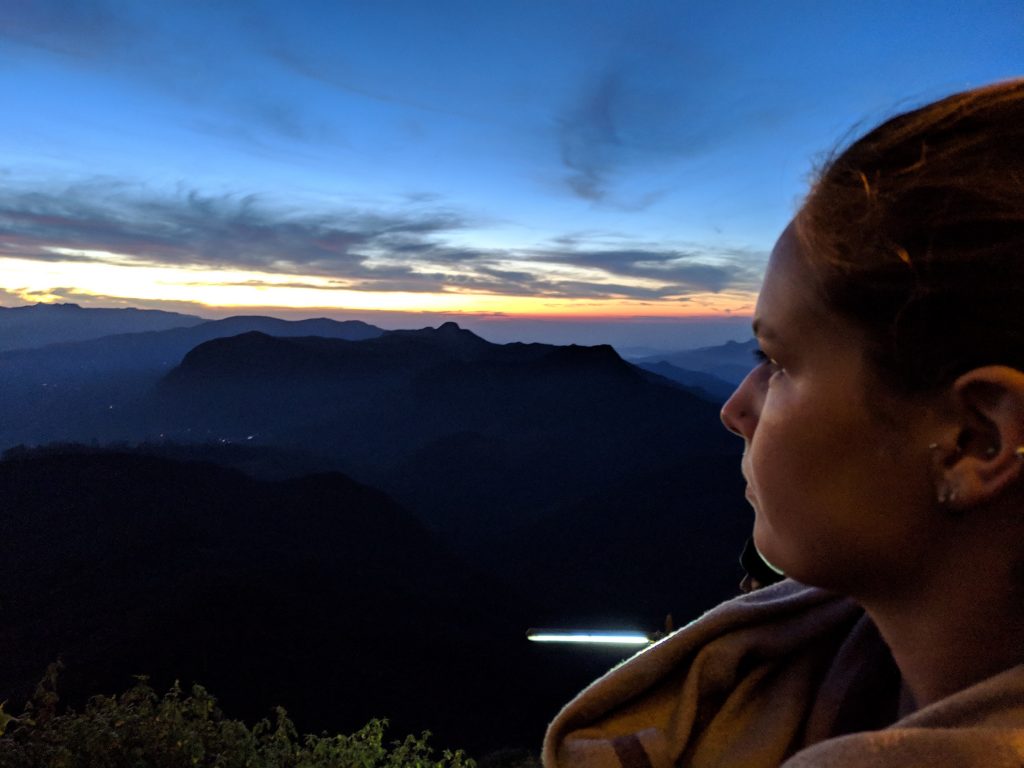
Unfortunately this is slanted to your labral perceptions.
Kosmos Journal you must do better than this.
Without doubt, Planet Earth and its shipload of eight (8) billion people are undergoing a remarkable transformation, physically, emotionally and economically. Those of us who have experienced the benefits of living, working and being educated in several global areas understand the research projected in this article. And some of us who have had an educational trajectory that includes both Math and Art understand that the concept of a changing emotional, experiential and conceptual sphere of inter-relationships may indeed be happening at lightning speed.
The amount of information the average person is exposed to is making it almost impossible to discern what the core ‘truth’ or meaning may be for each of us. How do you balance, for example, the information provided by Einstein’s Theory of Relativity and the Covid 19 assault of misinformation, with a poem or the emotional agony of a perfectly healthy person who completely distrust the spin stories by the CDC, WHO and the self-serving profit based politics of our pharmaceutical corporations?
The amount of stimulus generated by Google’s Mathematical search engines is machine, marketing and political brain washing (The current term of choice for a problem-solving procedure, algorithm, is commonly used nowadays for the set of rules a machine) and may suggest an emerging AI-Human Being global interface. But it is skewed, and disrespectful.
Hwever, we have no assurance that what we are experiencing is a reliable and human centered global consciousness evolution. The author’s statement “Today, the world is poised at the cusp of transformation from a society based on knowledge to one guided by consciousness” will require a massive intervention in the manner our high tech and media companies are allowed to operate.